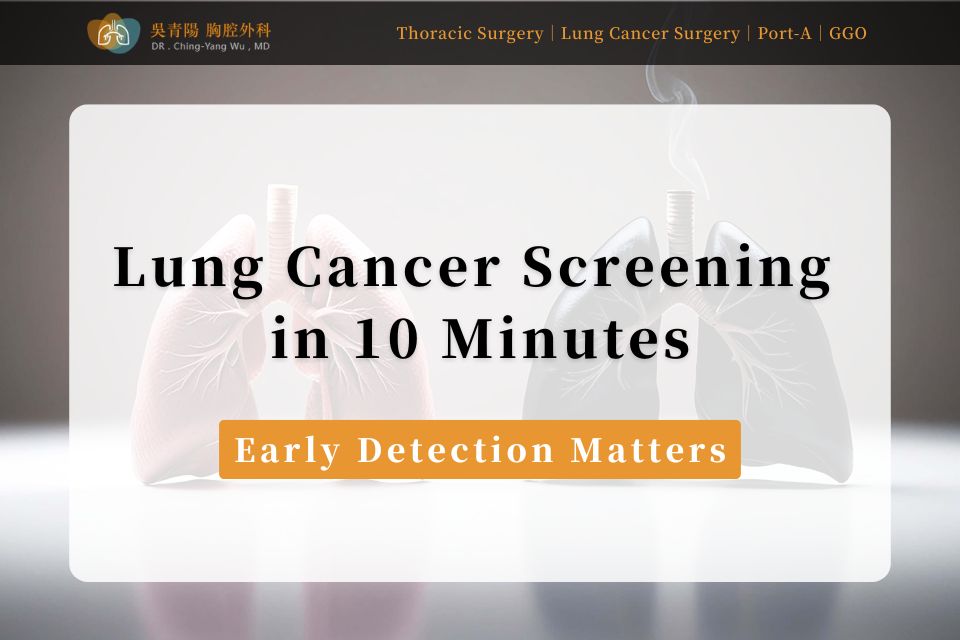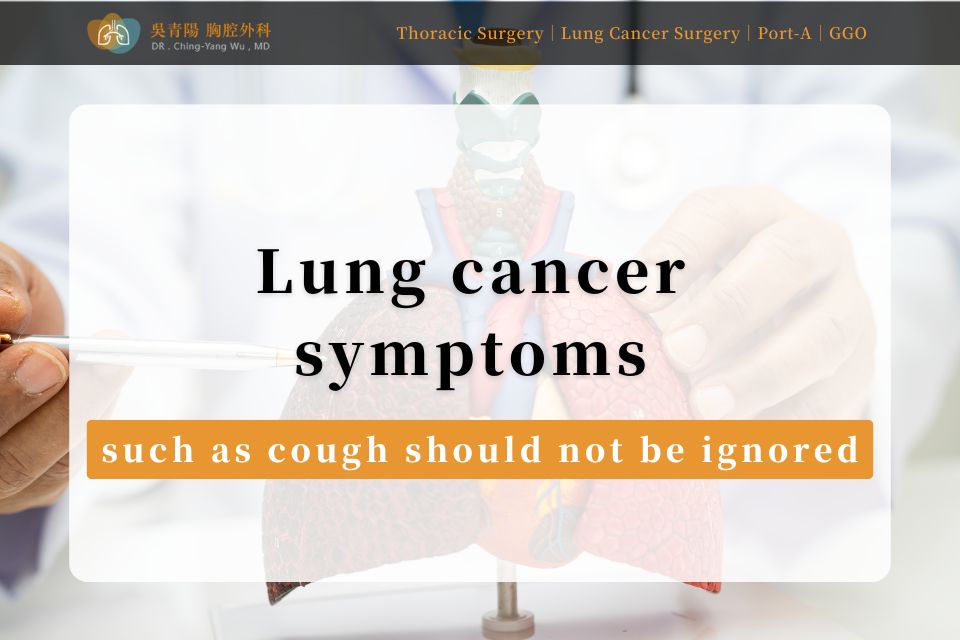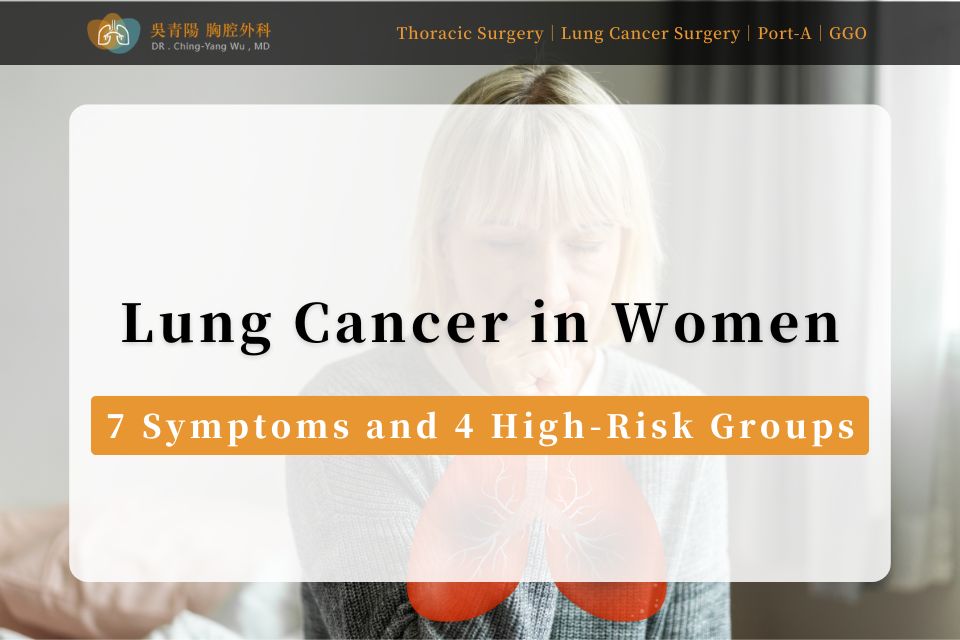
Lung Cancer Screening in 10 Minutes: Early Detection Matters
Lung Cancer Screening Explained: Master Early Detection in 10 Minutes
Lung cancer has long been the leading cause of cancer-related deaths worldwide. One major reason is that early-stage lung cancer often shows no symptoms, leading to late diagnoses and missed treatment opportunities.
To improve early detection rates, the government has launched a lung cancer screening program, offering free or low-cost lung cancer screening using low-dose computed tomography (LDCT) for high-risk individuals.
In this article, we’ll walk you through the lung cancer screening process, explain the different screening methods available, and show how early detection through lung checkups can significantly increase treatment success rates.
Lung Cancer Screening
Lung Cancer Screening Methods: What Are Your Options?
There are three main types of lung cancer screening methods commonly used today:
★1. Imaging Tests
- Low-dose computed tomography (LDCT):This is the preferred method for lung cancer screening. It can detect small lung nodules and help identify early-stage lung cancer, significantly reducing lung cancer mortality among high-risk individuals. LDCT remains the gold standard for lung cancer screening.
- Chest X-ray:A more traditional imaging method. Compared to LDCT, it has lower sensitivity for small nodules and is more likely to miss early-stage lung cancer.
★2. Cytology Tests
- Circulating Tumor Cell (CTC) Detection:CTCs are cancer cells that detach from the primary tumor and enter the bloodstream. Their presence is often linked to poor prognosis, and they are being investigated as a potential screening tool for high-risk individuals, such as heavy smokers or those with a family history of lung cancer.
While CTCs offer a minimally invasive approach to cancer detection, their clinical utility in screening remains limited. The main challenges include their extreme rarity, biological heterogeneity, lack of standardized detection methods, and low sensitivity for identifying early-stage disease.
At present, CTC analysis is more appropriately positioned as a complementary tool for prognosis, disease monitoring, and guiding personalized therapy, rather than as a standalone replacement for low-dose computed tomography (LDCT) in lung cancer screening programs. - Circulating Tumor DNA (ctDNA) Testing:ctDNA testing is a form of liquid biopsy that, while less invasive, serves a function similar to tissue biopsy. It can be used to detect lung cancer–related genetic mutations, such as EGFR and KRAS, offering valuable information for personalized treatment planning.
However, this method is still in the research phase and not yet widely used for routine lung cancer screening. - • MicroRNA (miRNA) Testing: MicroRNAs (miRNAs) are small, non-coding RNA molecules that play a key role in gene regulation. Elevated levels of specific miRNAs have been identified in patients with lung cancer and can be detected in blood, saliva, or sputum samples.
Because of their accessibility, miRNAs are being actively studied as a non-invasive screening tool.
Similarly, messenger RNA (mRNA) biomarkers provide valuable insights into tumor biology and may enhance early detection, subtype classification, and risk stratification.
Nonetheless, challenges such as molecular instability, limited sensitivity for early-stage disease, biological variability, and the absence of standardized, validated panels currently restrict the application of mRNA assays as frontline tools in lung cancer screening. - Tumor Protein Biomarker Tests (e.g., CEA, CYFRA 21-1, NSE):These markers can be measured in blood or other body fluids and may indicate the presence of cancer. While CEA, CYFRA 21-1, and NSE are useful for monitoring disease progression and prognosis, their limited sensitivity and specificity make them unsuitable for early-stage lung cancer screening.
Lung Cancer Screening: 5 Steps Not to Miss
The goal of lung cancer screening is to detect lung cancer at an early stage—before any symptoms appear.Early detection gives patients more treatment options and significantly improves survival rates.
Here are the common steps involved in a lung cancer screening process.
Your doctor will tailor the screening plan based on your individual risk factors and overall health condition:
★1. Initial Risk Assessment
Your doctor will ask about your medical history, age, and smoking habits to determine if you fall into a high-risk group for lung cancer.
For example, screening is generally recommended for individuals who meet all of the following criteria:
- Aged 50 to 80 years
- Have a 30-pack-year smoking history (e.g., one pack a day for 30 years)
- Currently smoke or quit within the past 15 years
These individuals are considered prime candidates for low-dose lung cancer screening.
★2. Low-Dose Computed Tomography (LDCT)
For individuals who meet the high-risk criteria, doctors typically recommend an annual low-dose CT scan.
LDCT can detect small lung nodules that are often missed by traditional chest X-rays, making it the most widely accepted and effective tool for early-stage lung cancer screening.
★3. Result Evaluation and Follow-Up
After the low-dose CT scan, your doctor will evaluate the results to determine if there are any suspicious nodules or abnormalities in the lungs.
If any abnormal findings are detected, your doctor may recommend further follow-up, which could include additional imaging or a biopsy to confirm whether the lesion is malignant.
These steps are crucial for accurate diagnosis and timely treatment if lung cancer is present.
★4. Additional Tests (Case-by-Case Basis)
In specific cases, your doctor may order lung cancer blood tests that measure tumor markers such as CEA, CYFRA 21-1, or NSE, to monitor disease progression or assess treatment response.
However, these tests are not routinely used for lung cancer screening due to their limited sensitivity and specificity. They are typically used alongside imaging studies to provide a more complete clinical picture.
★5. Genetic Testing (For Diagnosed Cases)
If lung cancer is confirmed, your doctor may order genetic mutation testing—such as EGFR, KRAS, or ALK—to help determine the most appropriate targeted therapy or immunotherapy options.
These tests are not used for screening, but are essential for treatment planning and personalized care in diagnosed cases.
Lung Cancer Early Detection Program: 10-Minute Screening That Could Save Your Life
Lung cancer is the leading cause of cancer-related deaths worldwide, largely because it is often diagnosed at a late stage, when treatment options are limited and the chances of a cure are significantly reduced.
To improve early detection rates, the Ministry of Health and Welfare has implemented a lung cancer screening program that uses low-dose computed tomography (LDCT) as a primary detection tool.
This government-funded screening is offered to high-risk individuals to help identify lung cancer at an early, more treatable stage.
| Screening Method | Low-Dose CT Scan (LDCT) | Traditional Chest X-ray |
| Detection of Small Nodules | Can detect smaller lung nodules | May miss small lesions |
| Early Detection Rate | High | Low |
| Reduction in Mortality | Can reduce lung cancer mortality by 20% (NLST study) | No significant reduction in mortality |
Which Hospitals Offer Free Lung Cancer Screening?
According to the Health Promotion Administration, individuals must meet all of the following criteria to be eligible for government-funded LDCT lung cancer screening:
- Aged between 50 and 74 years
- Have a smoking history of at least 30 pack-years(e.g., 1 pack per day for 30 years, or 2 packs per day for 15 years)
- Are current smokers, or have quit smoking within the past 15 years
A full list of hospitals that provide government-funded lung cancer screening and their contact information can be found on the official website of the Health Promotion Administration.
Dr. Ching-Yang Wu, thoracic surgeon, currently practices at Linkou Chang Gung Memorial Hospital and Taoyuan Chang Gung Memorial Hospital—both of which are designated hospitals for free LDCT lung cancer screening.
Eligible individuals are welcome to visit the lung cancer screening clinic at either location for further consultation.
Lung Cancer Genetic Testing: Key to Prevention and Treatment
The frequency of gene mutations in lung cancer varies depending on the type of lung cancer—such as non-small cell lung cancer (NSCLC) or small cell lung cancer (SCLC)—as well as other factors like the patient’s smoking history and geographic region.
There are notable geographic and ethnic differences in the prevalence of lung cancer gene mutations. For example, the EGFR mutation is more common among Asian patients, while the KRAS mutation is more frequently seen in Western populations, particularly among smokers.
Below is an overview of the approximate prevalence of common lung cancer–related gene mutations:
★Non-Small Cell Lung Cancer (NSCLC)
Non-small cell lung cancer (NSCLC) accounts for approximately 85–90% of all lung cancer cases.
Several gene mutations are commonly found in NSCLC, many of which play a critical role in selecting appropriate targeted therapies or immunotherapy.
Common genetic mutations in NSCLC include:
- EGFR (Epidermal Growth Factor Receptor) Mutation:Found in about 10–15% of NSCLC patients overall, but occurs in 30–40% of Asian patients, especially among non-smokers.
- KRAS (Kirsten Rat Sarcoma Virus) Mutation:Present in approximately 25–30% of patients with lung adenocarcinoma (a subtype of NSCLC), and is typically associated with smokers.
- MET Amplification (Mesenchymal-Epithelial Transition Factor):Detected in around 3–5% of NSCLC patients. It is often linked to a poorer prognosis.
- ALK (Anaplastic Lymphoma Kinase) Rearrangement:Found in about 3–5% of NSCLC cases, usually in younger, non-smoking patients.
- BRAF (B-Raf Proto-Oncogene) Mutation:Occurs in roughly 1–3% of NSCLC patients, and is generally associated with a history of smoking.
- RET (Rearranged During Transfection) Rearrangement:Identified in around 1–2% of NSCLC patients.
★Small Cell Lung Cancer (SCLC)
Small cell lung cancer (SCLC) accounts for approximately 10–15% of all lung cancer cases.
Compared to NSCLC, genetic mutations in SCLC are less well-defined, but several common alterations have been identified and are under ongoing research.
Common genetic mutations associated with SCLC include:
- TP53 (Tumor Protein p53) Mutation:Detected in approximately 90% of SCLC cases.
- RB1 (Retinoblastoma Protein) Mutation:Found in about 80% of cases and considered a hallmark of SCLC.
- Other mutations:such as NOTCH1 and PIK3CA alterations, are also observed, though they are less common.
The presence of certain gene mutations in lung cancer can directly influence treatment decisions.
Through genetic testing, doctors can gain a better understanding of the tumor’s molecular profile and select the most appropriate therapy, improving treatment outcomes.
For example:
- EGFR mutation:Patients with epidermal growth factor receptor (EGFR) mutations may benefit from tyrosine kinase inhibitors (TKIs). These targeted therapies act directly on the mutated pathway, offering more precise and effective treatment.
- ALK rearrangement:Patients with anaplastic lymphoma kinase (ALK) rearrangements can be treated with ALK inhibitors, which target the specific genetic alteration driving the cancer.
- KRAS mutation:Although historically considered difficult to treat, new therapies for KRAS mutations are emerging, providing more treatment options for patients with this mutation.
These genetic test results not only help doctors tailor personalized treatment strategies, but also allow patients to avoid ineffective therapies, unnecessary side effects, and wasted time.
In cancer treatment, seizing the optimal treatment window is critical—and genetic testing is the first step toward precision medicine.
Lung Cancer Screening Methods: The Right Test Leads to the Right Treatment
Q1. Are there hospitals that offer free lung cancer screening?
Yes. You can visit the official website of hospitals participating in the Health Promotion Administration’s lung cancer screening program to check availability.
Free low-dose CT (LDCT) screening is available for individuals who meet the following eligibility criteria:
- Classified as high-risk (e.g., current or recent smokers)
- Within a specific age range (typically 50 to 80, depending on the guideline)
- Have a 30 pack-year smoking history
- Are in sufficient health to undergo potential treatment if cancer is detected
Q2. How long does cancer genetic testing take?
The testing process for cancer genetic analysis typically takes around two weeks.
However, the exact timeframe may vary depending on factors such as specimen processing, the type of genetic panel, and the medical facility performing the test.
It’s best to consult your doctor to confirm the expected turnaround time and to track the progress of your results.
Q3. Does a high NSE level in lung cancer screening mean you have cancer?
A high NSE level does not necessarily indicate lung cancer.
NSE (neuron-specific enolase) can also be elevated due to non-cancerous conditions such as fatty liver or pneumonia. Additional tests, especially imaging studies, are needed to confirm the diagnosis.
Q4. Are blood tests reliable for cancer detection?
Blood-based tumor marker tests are not accurate enough to be used alone for lung cancer screening.
Due to limited sensitivity and specificity, these tests are still largely in the experimental stage and lack standardization—making them prone to false positives and false negatives.
Currently, low-dose computed tomography (LDCT) remains the standard screening method for individuals at high risk of lung cancer.
Q5. What is the prevalence of gene mutations in lung cancer?
The prevalence of gene mutations in lung cancer depends on the cancer type and geographic region.
Non-small cell lung cancer (NSCLC) accounts for about 85–90% of all cases.
- EGFR mutation: 30–40% in Asian patients
- KRAS mutation: 25–30%
- ALK rearrangement: 3–5%
- Other mutations (BRAF, MET, RET): 1–5%
Small cell lung cancer (SCLC) commonly involves TP53 and RB1 mutations.
Lung cancer care with Dr. Ching-Yang Wu.
The accuracy of lung cancer screening directly impacts patient survival.
Low-dose computed tomography (LDCT) is currently the most effective screening method, capable of detecting small lung nodules at an early stage and significantly improving treatment success rates.
Dr. Ching-Yang Wu is a thoracic surgeon at Linkou and Taoyuan Chang Gung Memorial Hospitals, specializing in lung cancer diagnosis and treatment.
With extensive clinical experience, he provides personalized treatment plans tailored to each patient’s condition.
Whether surgery, targeted therapy, immunotherapy, or chemoradiation, Dr. Wu develops the most suitable strategy to help patients improve survival outcomes and quality of life.
If you are at high risk for lung cancer, regular screening and early consultation with a specialist are strongly recommended.
You can also contact Dr. Wu directly via LINE for further medical support.



